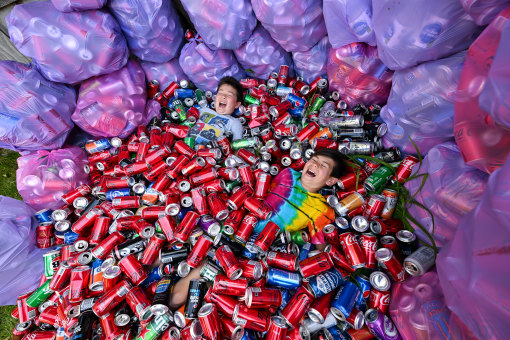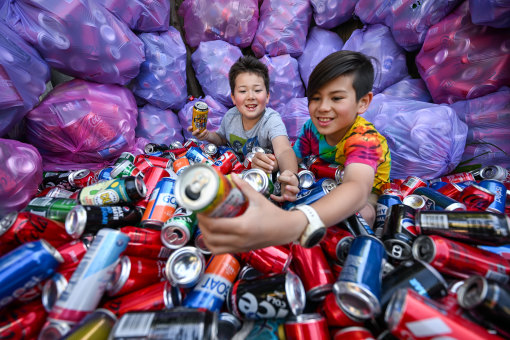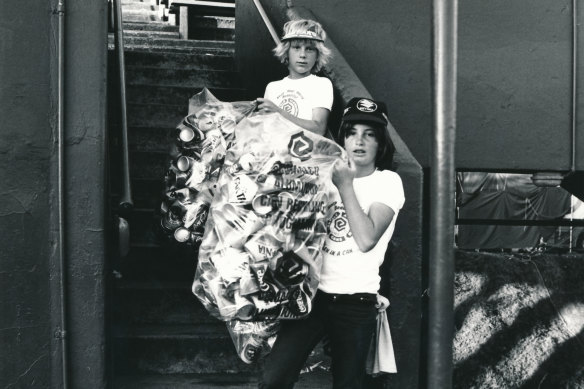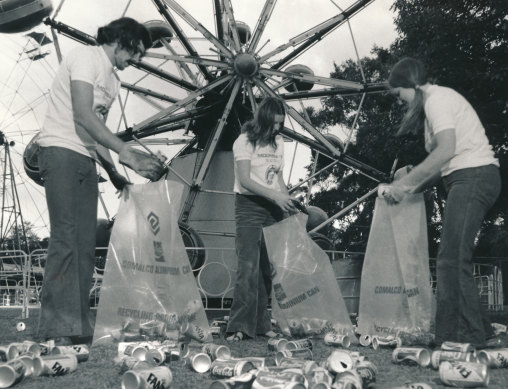The 10-year-old super-collector of bottles and cans set to cash in
Save articles for later
Add articles to your saved list and come back to them any time.
Melbourne super-collector Ashton Hanson is a boy on a mission.
He wants to collect 10,000 used cans and bottles in a year, and he’s not relying on stumbling on them by chance on the way to school.
Canny hobby: Ashton Hanson (right) and brother Xavier.Credit: Joe Armao
The 10-year-old is approaching the task with preparation, precision and a little help from his siblings.
Ashton is well ahead of the curve – the Victorian government’s Container Deposit Scheme doesn’t start until November 1.
But in an echo of the collecting craze in the 1970s, he’s already collected 4000 bottles and cans since May at his home in Bentleigh East in Melbourne’s south-east.
Ashton even records them diligently on a spreadsheet.
Return serve: Ashton Hanson, 10, (right) with brother Xavier are aiming to collect 10,000 cans.Credit: Joe Armao
He has recruited his brothers Lucas, 12, and Xavier, 7, to help, with an understanding that they can share the Lego pieces and an air hockey table he wants to buy with the proceeds.
Under the scheme, which gives back 10 cents per piece, the boys would earn $1000 from 10,000 pieces.
Most weekends, Ashton – with or without siblings – rides his bike or walks, wielding bags, around local streets looking for cans and bottles. “He’ll easily put in one or two hours at a time,” says his mother, Kim Hanson.
At other times, his parents will drive him to local railway stations to search.
Two boys collecting cans during the Australian Open tennis tournament in 1978.Credit: Fairfax Media
“He’ll bring them home, empty any liquid, count them and put them into different boxes and bags for cans, bottles and juice boxes. He tallies up the numbers in a spreadsheet every week.”
Kim keeps boxes for staff at her workplace – a Moorabbin art supplies company – to add bottles and cans.
“Some of them bring items from home to add to it. Family and friends leave things aside, so that when we catch up with them, they pass on their collection.”
Ashton doorknocks neighbours he knows in his street, and some keep bottles and cans aside for him.
He wrote an eloquent speech for doorknocking, telling residents that apart from helping the environment by recycling, “you will have less rubbish”.
“I will make it easier for you by collecting your cans and bottles every weekend, or whenever suits you,” he recites.
Ashton tells them they are also supporting kids’ health. “We are more active by going for walks, bike rides. I am spending more time outdoors with my family. I will get to know my neighbours.”
The script finishes off with “would you like to help us? Thank you for your time.”
After a few weeks away recently, Ashton collected over 200 bottles and cans, from six neighbours.
Members of the West Melbourne Baptist Church youth club collect cans at the Moomba Festival in 1975.Credit: Fairfax Media
Kim is not surprised by her industrious son’s efforts. “He’s always got some ambitious project on the go,” she says.
He used to breed stick insects for pet shops, is growing potatoes, and collected acorns, now oak saplings, that he plans to plant on his grandparents’ farm.
Kim is proud of the bottles and cans project. “I think it’s amazing. He’s demonstrated a lot of skill in putting it together and running it, and he’s had a lot of fun doing it, with his brothers.”
Ashton said he was doing it for money and to help the environment, but he also enjoys counting his collection and the exercise. “It can be tiring at times, but it’s pretty fun,” he said.
A state government spokesperson said they didn’t encourage people to stockpile.
“It’s fantastic to see young Victorians enthusiastic about recycling, however we encourage people to continue using their kerbside bins before the scheme begins,” the spokesperson said.
Locations of hundreds of refund points across Victoria, in the form of reverse vending machines, depots, and over-the-counter and pop up outlets, are expected to be announced in late October.
The spokesperson said large quantities – hundreds and thousands – of cans and bottles, should be taken to depots, rather than to reverse vending machines.
Most 150ml to three litre drink containers are eligible for a 10-cent refund – provided they are made from glass, plastic, aluminium, steel, or liquid paperboard (the latter often used for small juice drinks).
Cans should not be crushed, to allow the label to be read and the barcode to be scanned at refund points.
The scheme is being funded by the beverage industry, and the 2019-20 Victorian state budget allocated $8.6 million to deliver it.
The state government claims it will reduce the amount of litter in the state by up to half.
It is estimated that 1 billion containers will be returned in the first year of the scheme, resulting in $100 million refunded to Victorians, charities and community groups.
The number of returned containers is expected to grow in following years as Victorians become more familiar with using the scheme.
cdsvic.org.au
Start the day with a summary of the day’s most important and interesting stories, analysis and insights. Sign up for our Morning Edition newsletter.
Most Viewed in National
From our partners
Source: Read Full Article



